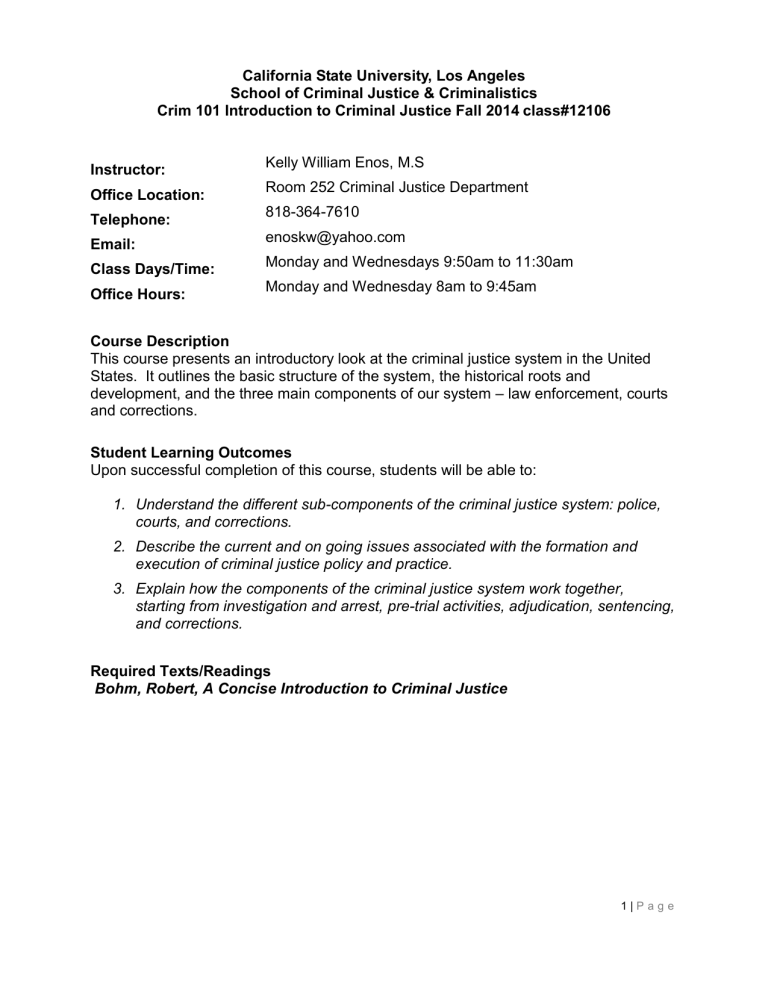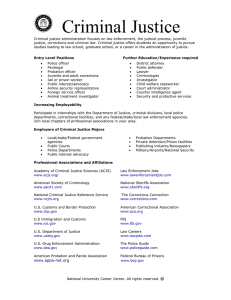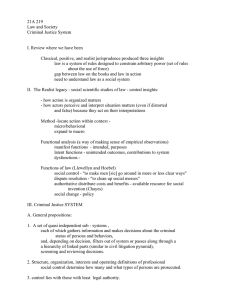Crim 101 Fall 2014 New Syllabus.doc

California State University, Los Angeles
School of Criminal Justice & Criminalistics
Crim 101 Introduction to Criminal Justice Fall 2014 class#12106
Instructor:
Kelly William Enos, M.S
Office Location:
Room 252 Criminal Justice Department
Telephone:
818-364-7610
Email:
Class Days/Time: enoskw@yahoo.com
Monday and Wednesdays 9:50am to 11:30am
Office Hours:
Monday and Wednesday 8am to 9:45am
Course Description
This course presents an introductory look at the criminal justice system in the United
States. It outlines the basic structure of the system, the historical roots and development, and the three main components of our system
– law enforcement, courts and corrections.
Student Learning Outcomes
Upon successful completion of this course, students will be able to:
1. Understand the different sub-components of the criminal justice system: police, courts, and corrections.
2. Describe the current and on going issues associated with the formation and execution of criminal justice policy and practice.
3. Explain how the components of the criminal justice system work together, starting from investigation and arrest, pre-trial activities, adjudication, sentencing, and corrections.
Required Texts/Readings
Bohm, Robert, A Concise Introduction to Criminal Justice
1 | P a g e
Assignments and Grading Policy
GRADING
2 Quizzes
Mid Term
Interview
Movie review
20pts each
100pts
25pts
25pts
Profile paper
Ethical dilemma paper
Final Exam
Total
25pts
25pts
100pts
340pts
Extra credit 15pts
100-90= A 89-80=B 79-70=C 69-60=D 59 or Below=F
*Note: There is a total of 340 points possible for this class. In order to calculate your grade, add up the total points you receive and divide that by 340. No make up exams
will be given.
Attendance: Regular attendance is the only way to properly satisfy the course requirements. Students are expected to arrive for class on time. You are required to make up missing lectures/discussions/class notes by contacting another student in the class and getting his/her notes.
Cell phones: cell phones WILL be turned off during class hours. All types of electronic devices (e.g. cell phones, pagers, personal digital assistants, laptops) are prohibited in class without prior approval. You are subject to removal if any of the above is used in class.
University and School Policies
Students are responsible for knowing and adhering to all University and School policies.
The University policies and procedures can be found at: http://web.calstatela.edu/student/index.htm
. The School of Criminal Justice &
Criminalistics Handbook for Students is located at: http://web.calstatela.edu/academic/hhs/crim_jus/PDF/Undergrad_Handbook.pdf
.
(NOTE: Links to the handbooks should be modified for graduate level courses.)
Academic Honesty
Students are expected to abide by the University’s Academic Honesty Policy: http://web.calstatela.edu/univ/stuaffrs/jao/doc/ah.pdf
Americans with Disabilities Act (ADA)
Reasonable accommodation will be provided to any student who is registered with the
Office of Students with Disabilities and requests needed accommodation.
2 | P a g e
11
12
13
14
15
16
17
7
8
5
6
9
10
2
3
4
Course Schedule
Session Date
1
Session Topic
9/29 Introduction to course
Readings and Assignments
10/1 Overview of the Criminal Justice
System
10/6 Explanations for crime
Chapter 1
Class notes
10/8 Explanations for crime
10/13 The Crime Picture
10/15 History of Policing in America
10/20 Structure of American Policing
Quiz 1&2
10/22 Issues in Policing
10/27 Issues in Policing
Class notes
Chapter 1
Chapter 2
Chapter 3
Chapter 4
Chapter 4
10/29 Midterm Exam review/ Jeopardy game Profile and ethical paper due
11/3 Midterm Exam Chapters 1 thru 4
11/5 Structure and Role of the Courts
11/10 Roles in the Court System
11/12 Pretrial and Trial Process
11/17 Pretrial and Trial Process
11/19 Memorial Day, campus closed
11/24 Sentencing Quiz 5&6 / Interview/ movie review due/x credit
Chapter 5
Chapter 5
Chapter 5
Chapter 5
Chapter 6
3 | P a g e
Session Date
18
19
Session Topic
11/26 Structure and Purpose of
Corrections
12/1 Life in Prison
20
Readings and Assignments
Chapter 7,8
12/3 Final exam review/Jeopardy game
Chapter 8
Final Exam 12/10 Final exam 8:00am to 10:30am Chapters 5 thru 9
*Tasks and timelines subject to change. Any changes will be announced ahead of time in class.
Students are responsible for staying informed of any changes throughout the quarter.
Required Assignments
1 .
Interview a Bail Bonds agent . There are hundreds of bail bond offices in Los Angeles.
You are to interview an agent in person at their office and determine what their job is, what some of their challenges are and how they interact with the law enforcement community and the courts. Summarize your interview in a two page paper, produced in a Microsoft WORD program. You a re to include the person’s name, contact number in the report and staple their business card to the report. Grammar, spelling and flow of content will be considered for your grade on all assignments.
2.
View the movie “12 Angry Men”, either the earlier or later version. The video is about jury deliberations and how the twelve jurors arrive at a decision. After viewing the movie, answer the following questions: How many issues did the jurors bring up that suggested reasonable doubt? Exactly what were they? What is Reasonable Doubt? What is a hung jury? Write your report in a Microsoft WORD program and submit.
3.
Profile of an admirable police officer.
Select either someone you know in law enforcement or create a fictional character. Write a one to two page focused profile of this individual whose values, skills and actions you greatly admire and that make him/her an example of a professional police officer. The criteria used to assess or grade your paper will be based on qualities as the clarity, completeness, and persuasiveness of the profile, not the identity of the individual chosen. Report is to be written in Microsoft WORD.
4.
Ethical Dilemma . Imagine you are a police officer working for a small police department in
California. You are working alone at approximately 10pm when you see a car swerving in the roadway. Believing the driver might be intoxicated, you stop the vehicle and approach the driver. Upon contact, you discover the driver is your police chief and is very intoxicated. He is the only person in the car however; a small crowd is watching you from across the street at a night club. It is obvious to you he cannot safely drive the vehicle and is over the legal limit allowed by law. What are you required to do? What are your options? How much discretion do you have? Whatever course of action you take, what are the consequences? Write a one to two page report in Microsoft WORD explaining what you would do and how you would justify your decision to the rest of the police department and/or the public.
4 | P a g e



